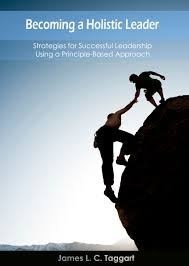10 Leadership Lessons to Succeed During Turbulent Change

Lesson #1: Commit to Your Job
There’s a saying that people don’t quit their jobs but rather their bosses. However, there comes a time when commitment to our work and employers must be reconciled with the tendency to leave jobs when we become frustrated. To commit to your job means aligning yourself with your organization’s mission, understanding who are the customers or clients, and determining where you add value. If you find that you’re not adding value, then some personal reflection is needed on either developing an exit plan or determining how you can contribute positively to the organization.
Lesson #2: Adapt Quickly to Change
When a big change hits your organization, emulate Superman by quickly shedding your old corporate duds for the new approach. If you can’t find a phone booth, any office will do. But the key point here is to understand that your organization is about to go through some whitewater change. By adapting quickly to the change, you’ll significantly reduce your stress while simultaneously showing management that you can be counted upon when the going gets tough and ambiguity is the daily challenge.
Lesson #3: Learn to Focus and Go for Quality, Not Quantity
In organizational work, multitasking has the negative effect of valuing the superficial and mediocrity. In what has been labeled the knowledge age, in which employees are supposedly knowledge workers, multitasking is dumbing down organizations.
When it comes to leading people, being present is a vital element of effective leadership. If you’re trying to multitask while speaking to one of your co-workers who has dropped by your office, you send out the message loud and clear that the individual is not important. Focus on what your colleague is saying; at that moment he or she is the center of your attention.
Lesson #4: Be a Promise Keeper
When you keep your promises and commitments to your co-workers, staff and bosses, including those with whom you interact in your community, you’re viewed as someone with integrity and whose word is gold. When the situation arises where you’re unable to keep a promise, then it’s essential to take the time to explain what happened to the person or people who were affected. Refrain from making up excuses; just be up front and people will be much more likely to be understanding. They may even respect you more when they see you admitting a mistake and acknowledging that you’re human.
Lesson #5: Embrace Uncertainty and Ambiguity–Ride the Wave
Trying to resist the onslaught of whitewater change is futile. The metaphor of learning to ride the wave is very apt, one that creates a positive and energetic outlook. At the organizational level the effects of globalization–characterized by most work being capable of being done anywhere around the world, thanks largely to communications technology–are having profound effects on workers.
What’s important to keep at the forefront is not who’s right on the job distribution issue, but rather to identify what YOU control and do NOT control. You control your morale, willingness to learn and adapt, and desire to seek out new opportunities. By assuming the identity of a change master, you’ll greatly reduce the stress that’s generated when your organization goes through the gyrations of major changes. And you’ll signal to senior management that you’re equipped and ready to contribute to helping the organization meet its new challenges.

The amount of information is growing exponentially. It’s no doubt overwhelming with the massive onslaught of information we must try to absorb. As much as it’s important to keep learning and to expose ourselves to new ideas and perspectives, the critical skill to acquire is how to synthesize this data overload.
Lesson #7: Own your attitude and behavior
How often have you seen bosses or co-workers trying to dump their problems on others? What was the effect? Did anyone call the individual on it? What was the response from management? When behavior like this occurs it can have a corrosive effect on the team and even more broadly on the organization. Don’t turn a blind eye when you see it happening. Speak up and empower yourself to help correct the behavior. Lead by example.
Lesson #8: Be a problem solver. Not finger pointer
It’s easy to identify problems and complain about them. Some people excel at this. The bigger challenge is exploring solutions to problems, and especially doing so in a collaborative manner. When you approach your work from this perspective you automatically start adding value to your organization. Avoid the finger pointers; instead, seek out people who want to be part of finding effective solutions for organizational issues and problems. You’ll be seen as the person who makes things happen, who fixes problems and, especially, adds value to your organization.
Lesson #9: Practice what you preach
Treat people as how you like to be treated, whether it’s responding to a request for information from another unit in the organization or serving a customer, client or supplier. When others see that you act consistently in accordance with what emanates from your mouth, they’ll take you more seriously and respect you for your judgment and views. Aligning what you espouse and what you actually practice is a cornerstone to leadership integrity. This is essential to creating a loyal followership.
Lesson #10: Become a barrier buster
Avoid becoming entrapped in silo thinking, in which people hoard information, reject ideas from other parts of the organization (as well as from outside) and attempt to protect their turf. Rise above this and get known for being a barrier buster who openly shares information, connects people, and communicates effectively across organizational boundaries. You’ll get noticed by management as someone who understands the bigger picture and is contributing to the organization’s mission and vision.
This brings with it demands for new leadership approaches. Top-down, command and control management styles have no place in our new world. It’s about collaboration through worker self-empowerment, where calculated risk-taking is a daily endeavour and individual and collective learning is nurtured and valued.
Take some time to reflect on these ten leadership lessons.
Where do you see yourself strongest? Where do you see yourself needing to strengthen your skills?
Start small; focus on one or two areas. Commit yourself to becoming an effective leader.
By assuming the identity of a change master, you’ll greatly reduce the stress that’s generated when your organization goes through the gyrations of major changes.
– James Taggart
________________________________________________________________________________________________

"""
Articles from Jim Taggart
View blog
I am your servant. I do not come to you as a leader, as one above others. · When you read these word ...

The leadership field—and its cousin management—has an over abundance of information, from books, per ...

Accountability has become one of those words used in organizations that make people wince. Many year ...
You may be interested in these jobs
-
cashier, customer service
Found in: Talent CA 2 C2 - 3 days ago
2435138 Alberta Ltd Whitecourt, CanadaEducation: · Expérience: · Education · Secondary (high) school graduation certificate · Work setting · Retail business · Tasks · Operate cash register · Process money, cheques and credit/debit card payments · Scan items · Calculate daily/shift payments received and reconcile wi ...
-
automotive painting and refinishing technician
Found in: Talent CA 2 C2 - 3 hours ago
East End Auto Body Shop LTD Revelstoke, CanadaEducation: · Expérience: · Education · Registered Apprenticeship certificate · Tasks · Clean and maintain work space · Replace front end components, body components, doors and frame and underbody components · Mask and tape auto body surfaces in preparation for painting · Apply ...
-
truck dispatcher
Found in: Talent CA 2 C2 - 2 days ago
Red leaf Logistics Inc Brampton, CanadaEducation: · Expérience: · Education · Secondary (high) school graduation certificate · Tasks · Ensure accuracy of completed time sheets, payroll and other summaries · Ensure proper functioning of equipment · Light cleaning duties · Maintain work records and logs · Monitor pers ...



Comments